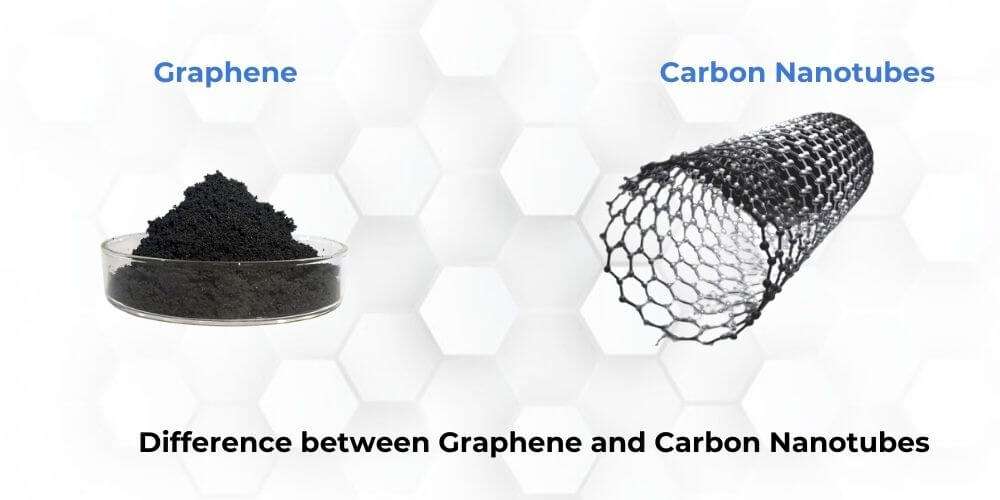Table of Contents
In the field of nanotechnology, two remarkable materials have been making waves for their unique properties and potential applications: graphene and carbon nanotubes. Both of them fall under the category of nanomaterials, which are incredibly small particles that exhibit extraordinary strength, conductivity, and other fascinating characteristics.
What is Graphene?
Graphene is a single layer of carbon atoms arranged in a two-dimensional honeycomb structure. This ultra-thin material is incredibly strong, flexible, and conducts electricity and heat with exceptional efficiency. Graphene’s structure and properties have sparked immense interest in various fields, ranging from electronics and energy storage to batteries and aerospace.
Key Properties of Graphene:
1. Exceptional Strength: Graphene is incredibly strong, with a tensile strength over 100 times greater than steel.
2. High Electrical Conductivity: It exhibits excellent electrical conductivity, making it an ideal material for electronic devices.
3. Flexibility: Despite its strength, graphene is highly flexible and can be bent without breaking.
4. Transparency: Graphene is nearly transparent, absorbing only about 2.3% of visible light.
5. Thermal Conductivity: It has superior thermal conductivity, which is useful in heat dissipation applications
What are Carbon Nanotubes?
Carbon nanotubes are tubular structures composed of rolled-up graphene sheets. These cylindrical nanostructures exhibit remarkable strength, thermal conductivity, and electrical properties, making them ideal for a wide range of applications. Carbon nanotubes come in different forms, such as single-walled and multi-walled variants, each with distinct characteristics and applications.
Key Properties of Carbon Nanotubes:
1. High Strength: Like graphene, carbon nanotubes are extremely strong, with some forms being even stronger.
2. Electrical Conductivity: CNTs can be either metallic or semiconducting, depending on their structure, making them versatile for various electronic applications.
3. Thermal Conductivity: They also exhibit excellent thermal conductivity, useful for managing heat in electronics.
4. Unique Structure: The tubular structure allows for unique mechanical properties, such as high flexibility and resilience.
Graphene vs. Carbon Nanotubes: Main Differences
While both graphene and carbon nanotubes boast impressive characteristics, their differences are significant and influence their respective applications.
Structural Differences
- Graphene: A flat, two-dimensional sheet of carbon atoms.
- Carbon Nanotubes: One-dimensional cylindrical structures, which can be single-walled (SWCNT) or multi-walled (MWCNT).
- Electrical Properties
- Graphene: Uniformly exhibits high electrical conductivity.
- Carbon Nanotubes: Can be either metallic or semiconducting based on their chirality (the angle at which the graphene sheet is rolled).
Mechanical Properties
- Graphene: Extremely strong and flexible.
- Carbon Nanotubes: Also very strong, with a high strength-to-weight ratio, and can be more flexible than graphene due to their tubular structure.
Synthesis and Production
- Graphene: Methods include chemical vapor deposition (CVD) and chemical reduction of graphene oxide.
- Carbon Nanotubes: Commonly produced using CVD methods.
Applications of Graphene and Carbon Nanotubes
Graphene Applications
1. Electronics: Used in the development of transistors, capacitors, and flexible displays.
2. Composites: Enhances the strength and conductivity of composite materials.
3. Energy Storage: Applied in batteries and supercapacitors for improved performance.
4. Biomedical: Potential uses in drug delivery, biosensors, and medical implants.
Carbon Nanotubes Applications
1. Electronics: Utilized in field-effect transistors (FETs), conductive films, and sensors.
2. Materials: Reinforcement in composites for aerospace and automotive industries.
3. Energy: Incorporated into battery electrodes and capacitors.
4. Nanomedicine: Explored for targeted drug delivery and imaging.
Graphene and carbon nanotubes are two extraordinary nanomaterials, each with distinct properties and a wide range of applications. Understanding their differences helps in choosing the appropriate material for specific technological advancements. As research continues, the potential for these materials to transform various industries remains immense.
Conclusion:
With the group of passionate researchers, ad-Nano has successfully launched different grades of graphene and carbon nanotubes for various application.
To buy graphene and carbon nanotubes : click here

